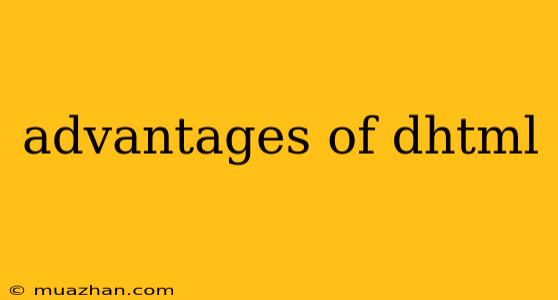Advantages of DHTML
Dynamic HTML (DHTML) is a combination of HTML, CSS, and JavaScript that allows for the creation of dynamic and interactive web pages. It's a powerful tool for web developers who want to create engaging and user-friendly experiences. Here are some of the main advantages of using DHTML:
1. Enhanced User Experience
DHTML enables the creation of interactive and dynamic web pages. This allows for more engaging user experiences. For example, DHTML can be used to:
- Create interactive forms and menus: Users can easily navigate and interact with forms and menus.
- Add animations and transitions: Smooth transitions and animations enhance visual appeal and user engagement.
- Display dynamic content: Content can be updated without requiring a page reload, improving user experience.
2. Improved Website Performance
DHTML can be used to optimize website performance by:
- Reducing page load times: Content can be loaded on demand, rather than all at once, improving loading speeds.
- Reducing server requests: DHTML can handle some tasks on the client-side, reducing the load on the server.
3. Greater Flexibility and Control
DHTML provides greater flexibility and control over web page elements. Developers can:
- Change the appearance of elements dynamically: Adjust styles, sizes, and positions in response to user actions or events.
- Control the flow of information: Display content selectively and modify its layout as needed.
- Create custom functionalities: Develop unique features and interactions tailored to specific website needs.
4. Enhanced Functionality and Features
DHTML allows for the implementation of advanced features and functionalities, such as:
- Drag and drop functionality: Users can easily move and rearrange content on the page.
- Real-time data updates: Information can be displayed dynamically, reflecting the most up-to-date data.
- Interactive maps and graphics: DHTML can be used to create interactive visual elements for a more engaging experience.
5. Cross-Platform Compatibility
DHTML is supported by major web browsers across different platforms, making it a widely accessible technology.
6. Cost-Effectiveness
DHTML is a relatively cost-effective way to create dynamic and interactive websites. The technology is readily available and there are many resources available to learn and implement it.
Conclusion
DHTML provides numerous advantages that can significantly enhance website functionality, user experience, and overall performance. It's a powerful tool for developers who want to create engaging and interactive websites that stand out in today's digital landscape.
